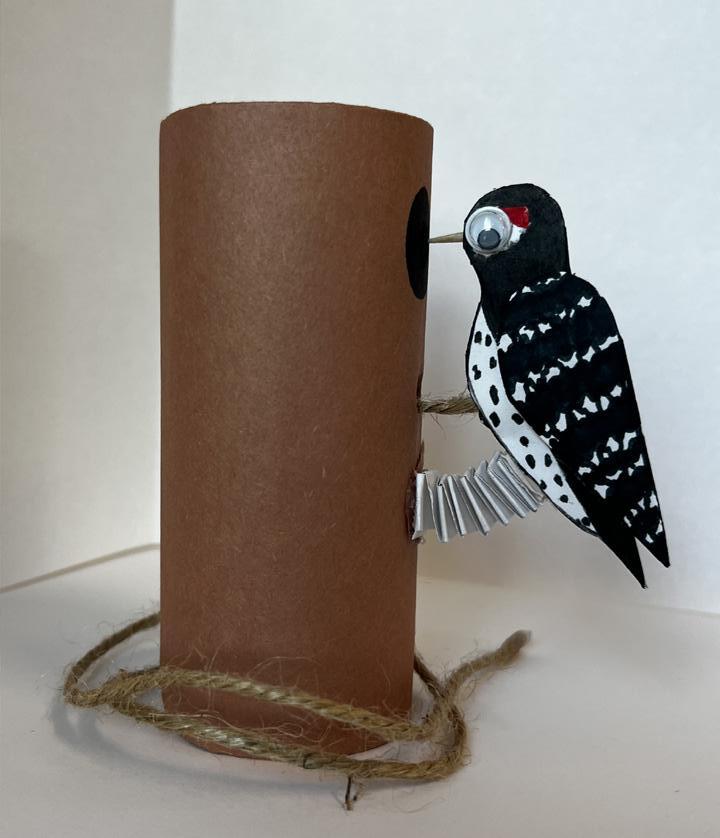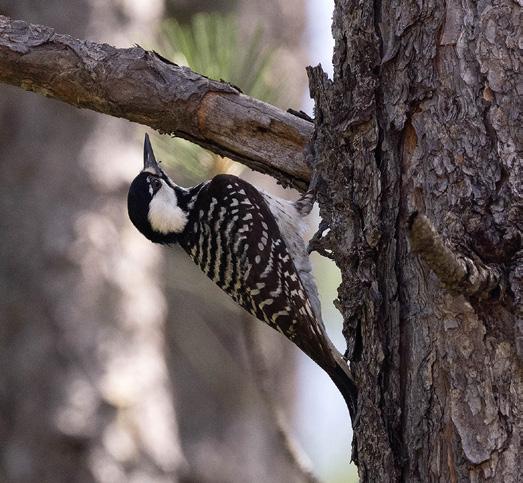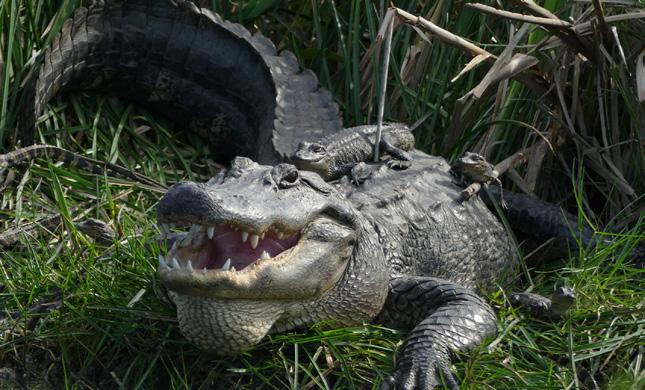CRITTER CONNECTIONS



ECOREGION

The longleaf pine, scientific name Pinus palustris, is a native tree found in the Piney Woods ecoregion of Texas. It is one of three native southern yellow pine tree species in East Texas. Once mature, this tree can stand over 100 feet tall and can have a trunk up to three feet in diameter! This tree has long, needle-like leaves that can grow up to 18 inches long and has thick scaly bark.
Like other pine trees, the longleaf pine is monoecious, meaning the male and female reproductive cones can be found on the same tree. Male cones make pollen and female cones protect the tree’s seeds. After about two years, the female cones will open, releasing small seeds. As they begin to grow, the seedlings will look like a fountain of pine needles instead of trees. This is called the grassy stage. Longleaf pines remain small for the first several years while growing deep and wide root systems. The roots continue to grow with

the tree, with an average taproot depth of 10-15 feet! These large root systems help them remain standing during severe weather like windstorms and hurricanes.
Longleaf pines are pyrophytic, meaning they are adapted to fire. Longleaf pines grow in large open stands with an understory of flowering plants, grass, and the occasional shrub. Naturally occurring fires kept the understory open, creating habitat for a wide variety of wildlife like the Redcockaded Woodpecker, Wild Turkey, white-tailed deer, native butterfly species, and more! Due to extensive logging and suppression of prescribed fire, this plant is not as common as it once was. Still, efforts across the longleaf pine tree range have restored this plant to some extent, benefiting both the ecosystems it is a part of and the wildlife that rely on it for survival.
For this craft, you will need a toilet paper roll or paper cup, construction paper, markers, glue, string, scissors, and a toothpick.
To begin, cover your toilet paper roll or cup with brown construction paper to create a tree trunk. Draw a small circle on the toilet paper roll. This will be the cavity.
On a piece of paper, draw a woodpecker. Carefully cut it out. Glue a small piece of a toothpick to the woodpecker for its beak.
Fold two thin strips of paper to create a spring (guide in provided link). Glue the woodpecker to one end of the spring. Glue the other end of the spring to the tree trunk you created in step 1, ensuring the woodpeckers beak lines up with the cavity.
Poke a small hole in the tree trunk halfway between the spring and the cavity. Pull a piece of string through the hole and glue it to the woodpecker. Your woodpecker is now ready to build its cavity!

Source: Pengee Arts (https://www.youtube.com/ watch?v=X1dAHa4gh3c)
Read the feature article to learn more about a unique woodpecker that lives in the Piney
… that Texas has 10 different ecoregions?
… that the longleaf pine tree can grow over 100 feet tall and can have a trunk up to three feet in diameter?
… that the Piney Woods ecoregion is a part of a bigger forested area covering Oklahoma, Arkansas, and Louisiana?
… that Caddo Lake has the largest cypress forest in the world?
… that the eastern gray squirrel plays an important role in regenerating the forest ecosystems?
… that the Red-cockaded Woodpecker is the only woodpecker species that builds cavities in living trees?
… that the American alligator is a legendary conservation success story?
… that American paddlefish are the oldest surviving species in North America?
… that the Piney Woods ecoregion is known for its diversity and robust ecosystems?
… that the work of conservationists, scientists, and citizens help this ecoregion’s natural resources thrive?




By Amber Brown

Texas is home to 10 different Gould’s ecoregions as seen on the map above. Ecoregions are areas of land that share similar climate, topography, and soils. In this series, we will dive into each of Texas’ 10 ecoregions one Critter Connections issue at a time. Next up – the Piney Woods!
The Piney Woods ecoregion can be found in far East Texas, running along the Texas-Louisiana state line and stretching from the Red River in the north to the Gulf Prairies ecoregion in the south. Some cities you can find in this ecoregion include Huntsville, Lufkin, Tyler, and The Woodlands. While most people picture open prairies or desert landscapes when thinking of Texas, the Piney Woods ecoregion is quite the opposite. This fascinating region of Texas is a part of a bigger forested area covering Oklahoma, Arkansas, and Louisiana. Despite its name, this ecoregion is made up of more than just pine trees! A stroll through the woods can lead you to open pine savannas, bottomland forests, dense thickets, hidden bogs, and swamps surrounded by towering cypress trees. Neat features like the Big Thicket, an area where multiple habitats meet, can be found here. Furthermore, along the Louisiana-Texas state line sits the largest natural freshwater lake in the state, Caddo Lake. Caddo Lake has the largest cypress forest in the world and has become a must-see for visitors to the region, thanks to its stunning natural beauty. Overall, the Piney Woods ecoregion is a unique area of Texas, known for its plant and wildlife diversity.
The Piney Woods ecoregion is home to many different mammals like the American beaver, flying squirrel, golden mouse, river otter, swamp rabbit, and white-tailed deer. A well-known mammal of this ecoregion, and one you’ve

likely seen, is the eastern gray squirrel. There are three squirrel species native to the Piney Woods ecoregion, but the eastern gray squirrel, also called cat squirrel, is the most common. These small, agile critters can be found jumping between tree limbs or foraging (searching) for nuts, seeds, fruit, and flowers on the forest floor. They are well adapted to life in the trees – sharp claws help them climb, long tails help them keep balance as they scurry along limbs, yellow filters in their eyes help them see in low light settings, and large eyes on each side of their head allow them to see around, above, and below. Like other squirrels, the eastern gray squirrel buries and stores food in caches to prepare for winter. Sometimes these critters forget where they bury their food and the seeds will germinate. This behavior plays an important role in regenerating the forest ecosystems and creates a mutualistic relationship between trees and squirrels. How neat!
Another native Texas critter you can find in the trees of the Piney Woods ecoregion is the Redcockaded Woodpecker. Despite their name, these birds are primarily black and white with only a small red patch on the cheeks of the males, called a cockade.
Red-cockaded Woodpeckers are the only woodpecker species that build cavities in living trees, preferring old large pine trees in open areas. When pecking out the cavities, these critters create a well of sap around the entrance to keep out predators like snakes. Red-cockaded Woodpeckers live in family groups made up of a mated pair, their chicks, and young helpers from previous nesting seasons. Their territory can include up to 30 trees across 60 acres and is made up of active cavities, abandoned cavities, and some under construction. In addition to providing nesting and roosting sites for woodpeckers, these cavities provide important habitat for over 35 other species of wildlife. Due to this, the Red-cockaded Woodpecker is a keystone species in the pine forests of East Texas. Red-cockaded Woodpeckers are considered endangered in Texas, but through conservation practices like artificial cavities and prescribed fire, conservationists are helping this species recover.


Another keystone species you can find in the Piney Woods ecoregion is the American alligator. While reptiles like the threatened Louisiana pine snake, the venomous semi-aquatic water moccasin, and even the largest freshwater turtle species in North America – the alligator snapping turtle – live in this ecoregion, few have a reputation as large as the alligator. American alligators can be found in the rivers, lakes, ponds, swamps, bayous, and marshes of East Texas. While these critters prefer freshwater, they can tolerate brackish waters and are often found near the Gulf Coast. American alligators are large, greenish-black, semi-aquatic reptiles that can grow up to 15 feet long and can live 30-40 years in the wild. They get their armored appearance from the bony plates, called scutes, covering their bodies. American alligators have long, rounded snouts and 80 teeth. They have one of the most powerful bites in the animal kingdom! Like other reptiles, alligators have three sets of eyelids. The two outer eyelids work like ours, closing from top to bottom. The inner eyelid, called a nictitating membrane, closes from back to front. This transparent third eyelid works like swimming goggles by protecting the eyes and helping the alligator see underwater. Alligators are skilled apex predators. Their great sight, sense of smell and hearing help them stalk prey without being seen. Often found swimming and floating in the water, these critters can hold their breath for up to 45 minutes and will use their powerful tail to propel them forward. Don’t let their size fool you. These large reptiles can also move quickly on land! American alligators are a common sight today, but that wasn’t always the case. In the 1960s they were listed as endangered due to habitat loss and overhunting. State and federal protections provided by the Endangered Species Act, the Lacey Act, and regulations on commercial trade helped this critter recover. Twenty years later, the alligator was removed from the endangered species list, cementing this critter as a legendary conservation success story. Now we won’t have to say ‘see you later’ to these alligators. With continued protection and habitat improvements, they will be around for a while.
In the Piney Woods waterways, swims the oldest surviving species in North America – the American paddlefish. Fossil records indicate this species is over 300 million years old,
Topography - an area’s physical shape; for example rivers, hills, and valleys
Germinate - to begin to grow
Mutualistic relationship - a relationship that benefits both critters
making it older than dinosaurs! Sometimes called a spoonbill or shovelnose, the paddlefish is a freshwater fish found in slow-moving rivers and lakes. These critters have a forked tail, gray skin, and a skeleton made of cartilage instead of bone. They can live to be over 30 years old, grow over seven feet long, and weigh up to 200 pounds. The paddlefish’s long, flat snout makes up about one third of its overall length and is covered in taste buds on the underside which may help it locate food in the murky waters it inhabits. These native Texas fish are filter-feeders, meaning they eat by swimming with their mouths open, catching tiny plants and animals, called plankton, and filtering them out with gill rakers. Paddlefish are threatened in Texas, and as such, it is illegal to catch, kill, or harm them.

Some of the challenges they face include habitat loss, dams and reservoirs changing water flow, poaching of their eggs for caviar, and the use of illegal gill nets. With continued protection and ongoing conservation efforts, these prehistoric critters can roam the Piney Woods waterways for many more years. Historically, this ecoregion was known for its diversity and robust ecosystems, thanks in part to its warm temperatures and average yearly rainfall. You could find animals like the Ivory Billed Woodpecker, red wolf, ocelot, and Louisiana black bear within this area. Over time, this ecoregion has changed due to logging, damming rivers, and urbanization. This has ultimately led to decreased diversity, decreased water quality, loss of wildlife habitat, and ultimately the loss of entire species from this range.
Still, the Piney Woods ecoregion has proven to be a resilient area. Interagency cooperations, private land management, declaration of state and federal lands, sustainable logging practices, and endangered species protections have shown that conservation efforts can make a positive impact on the plants and wildlife of this area. With the continued work of conservationists, scientists, and citizens, we will see the natural resources thrive. Whether you love the Piney Woods for the plants, the wildlife, the recreation, or the scenery, we can all agree this ecoregion is a special part of our state and as such deserves to be protected.
Keystone species - an animal or plant that plays an important role in its ecosystem or food web
Endangered - at risk of becoming extinct
Brackish - a mixture of freshwater and saltwater; occurs where rivers meet the gulf
Threatened - at risk of becoming endangered
Urbanization - the process of making an area more urban
www.texas-wildlife.org/critter-connections-library Visit the Critter Connections library for enrichment activities and resources to take your learning to the next level.
Article Source: The Natural History of Texas by Brian R. Chapman and Eric G. Bolen
Help the American paddlefish find its next meal of tasty plankton!

Visit the Critter Connections library at www.texas-wildlife.org/critter-connections-library to view the answer key.

Over the years, the Piney Woods ecoregion has captivated visitors with its natural beauty. The towering trees, fern-lined bogs, foggy cypress swamps, firefly-dotted forests, mysterious thickets, and insect-eating carnivorous plants can make this area feel like a fairytale setting.
Imagine you are an author visiting the Piney Woods ecoregion for the first time. Use what you have learned about this ecoregion along with your imagination to create your own conservation fairytale. Grab some colors or markers and illustrate your story!
Share your creation with us at www.texas-wildlife.org/critter-connections-magazine for a chance to be featured on our social media.



Texas Ecology | Natural Resources | Conservation | Stewardship
C lassroom & outdoor experiences for educators & students (at no cost)
Discovery Trunks
Hands-on materials and lessons shipped statewide to schools and sites
Wildlife by Design Classroom Presentations
Classroom & outdoor TWA Educator-led interactive in-person presentations
Land, Water & Wildlife Expeditions
Middle & High School program series culminating with a day of outdoor studies focused on land, water, and wildlife
Distance Learning
Interactive youth video lessons
Online Lessons
Online compilation of lessons emphasizing the action component of conservation and stewardship
Critter Connections
Quarterly kids magazine focused on native plants and wildlife

Professional Development
Trainings which increase participant conservation and stewardship knowledge and provide information about classroom resources

Youth Education
Adult Education

Texas Youth Hunting Program
Adult Learn to Hunt Program

Professional Development TWA is the leading voice for wildlife conservation policy in Texas.
Texas Big Game Awards



Please consider making a tax-deductible investment to TWAF, and help us as we continue to change minds and lives, through natural resource education. Together, we can make sure that Texans understand the importance of wild things, wild places, and the stewards who care for them.



